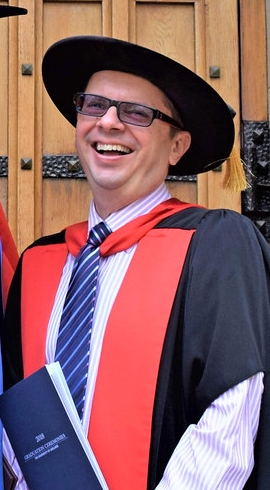Obituary - Catalin Tufanaru
Rest in peace Catalin. Sadly missed by all!
Obituary
Dr Catalin Tufanaru MD, MMPH, MClinSc, PhD
Born Brasov, Romania April 14th1970
Died Sydney Australia, July 29th 2021
Catalin Tufanaru was an enthusiastic and energetic scholar, researcher, teacher and writer in the fields of public health, statistics, evidence-based healthcare and the systematic review process. Graduating with an MD from the University of Medicine & Pharmacy “Carol Davila” in Bucharest, he trained and practised as a GP before undertaking Public Health Specialist Physician training through the Romanian Ministry of Health, Institute of Public Health and the Department of Public Health at the University of Medicine & Pharmacy “Carol Davila”.
 Born and growing up in the Ceaușescu era and conscripted for two years national service ending just as the revolution took place, he was disappointed in what he saw as corruption and elitism in the new democratic regime that emerged after the revolution and became a strong believer in free speech and vigorous, rigorous debate.
Born and growing up in the Ceaușescu era and conscripted for two years national service ending just as the revolution took place, he was disappointed in what he saw as corruption and elitism in the new democratic regime that emerged after the revolution and became a strong believer in free speech and vigorous, rigorous debate.
He went on to serve as a Public Health Researcher and Public Health Specialist Physician at the National Institute for Research and Development in Health in Bucharest. During that time, when attending a Guidelines International Network conference in Adelaide, Australia, he visited the headquarters of the Joanna Briggs Institute (JBI) and became determined to establish a Romanian JBI Collaborating Centre. With great tenacity, he pursued the bureaucratic processes of the Romanian public health system and successfully established the Centre, which is still active today.
In 2009, he applied for a research fellow position at JBI in Adelaide and he and his wife moved to Australia. They both very proudly became Australian citizens in 2014.
In the subsequent ten years in Adelaide, whilst carrying out research and teaching required of him, Catalin read widely and deeply across the fields of theology, philosophy and research methodology. This was partly related to his successful completion of a Master of Clinical Science and a PhD focusing on the philosophical and methodological bases to qualitative synthesis; but it was really Catalin’s passion and only hobby.
He was ardent in his views and will be remembered by his PhD student colleagues for his committed, vehement and sometimes controversial arguments about statistics, quantitative synthesis and qualitative synthesis. Researchers from all over the world who attended Catalin’s classes on statistics, evidence synthesis and the methodological issues and controversies surrounding evidence-based healthcare will remember his enthusiasm and focus.
During this period he made a number of significant contributions to JBI and the field of evidence-based healthcare. He was the main driver and first author on the JBI Guidance for Systematic Reviews of Effectiveness, methods that are widely used across the globe. He was involved in the redevelopment of both the JBI systematic review software (JBI SUMARI) and the JBI Systematic Review Training Program, attended by 1000+ participants every year. He supervised many students and was generous in his support of staff from the JBI Collaboration and elsewhere with their systematic reviews. He was pivotal in the redevelopment of many of the JBI Critical Appraisal tools and was a long serving contributor to the JBI Scientific Committee. In addition, he was also a Cochrane review author, a JBI review author and an important contributor to the Restoring Invisible and Abandoned Trials (RIAT) initative, being involved with the critical work of restoring Study 329. These examples are just a snapshot of the important work he produced throughout his career.
In 2018, he moved from Adelaide to Sydney to take up a Research Fellow position with the NHMRC Centre of Research Excellence in Digital Health, within the Australian Institute of Health Innovation (AIHI) at Macquarie University. Catalin quickly embedded himself in the research training program for both post-doctoral researchers, as well as Masters of Research and Medical Doctorate (MD) students. He became legendary for his enthusiastic and richly detailed lectures on systematic review methods and the process of evidence synthesis. His course materials will live on for many years and a white paper on literature reviews for students and researchers which he started with colleagues at AIHI will be completed, leaving an important legacy.
Not many months after joining AIHI Catalin received his diagnosis and he spent the next few years juggling work and his increasingly aggressive treatments. He remained optimistic and energetic throughout this period, despite many physical challenges. His research interests at AIHI were wide and he was always enthusiastic to be involved in many different projects. However his interest quickly converged on the use of AI and automation technologies to support systematic reviews, a topic about which he became increasingly expert and passionate. He read voraciously, and led multiple projects including the first attempt to replicate an automated systematic review. Catalin’s novel ideas for AI driven evidence synthesis were still in development when he suddenly became unable to work as his disease accelerated.
After a long illness courageously borne, Catalin, who was committed to his Romanian Orthodox faith, died at home with his wife Alina after being discharged from hospital the day before.
An unusual, passionate scholar, he will be missed by all who came to know and understand his thirst for knowledge. The kind of philosophical, methodological scholarship he personified is increasingly rare these days and will always garner enormous respect in evidence-based healthcare circles.
He leaves behind his mother in Brasov and his wife, Alina.
Prepared by Alan Pearson, Zachary Munn and Enrico Coiera
Centres related to this news
For further information, please contact
Chrissy Clay, Media and Research Outreach Coordinator
Follow us on Twitter @AIHI_MQ
News image photo by David Tomaseti on Unsplash
